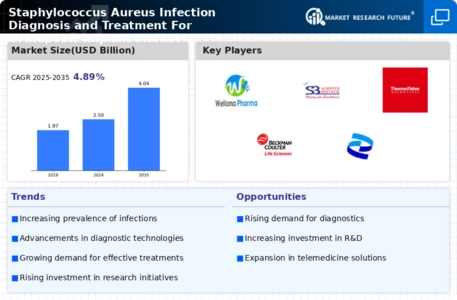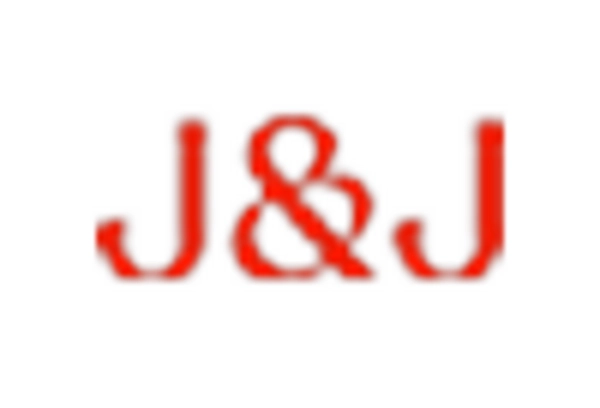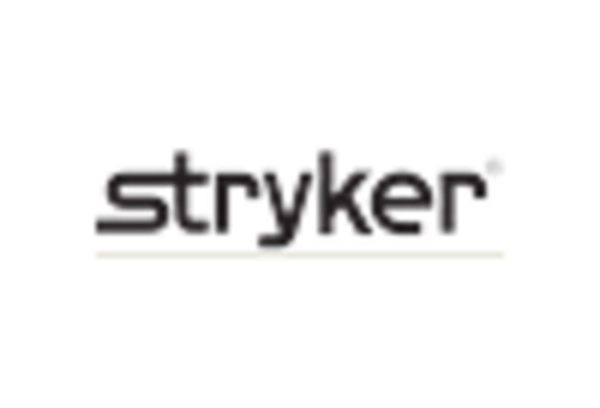Increase in Orthopedic Surgeries
The rising number of orthopedic surgeries globally is a significant factor driving the Staphylococcus Aureus Infection Diagnosis and Treatment For Orthopedic Implant Market. With an aging population and an increase in sports-related injuries, the demand for orthopedic procedures, such as joint replacements and fracture repairs, continues to escalate. Reports indicate that the orthopedic surgery market is projected to reach USD 60 billion by 2026, highlighting the growing need for effective infection management strategies. As the volume of surgeries increases, so does the risk of Staphylococcus Aureus infections, prompting healthcare providers to seek advanced diagnostic and treatment options. This trend is likely to create substantial opportunities for market players to develop innovative solutions tailored to the needs of orthopedic patients.
Growing Focus on Infection Control Protocols
The heightened emphasis on infection control protocols within healthcare settings is a critical driver for the Staphylococcus Aureus Infection Diagnosis and Treatment For Orthopedic Implant Market. Hospitals and surgical centers are increasingly adopting stringent infection prevention measures to reduce the incidence of Staphylococcus Aureus infections. This includes the implementation of preoperative screening, aseptic techniques, and the use of prophylactic antibiotics. According to recent data, facilities that adhere to these protocols have reported a 25% reduction in surgical site infections. As healthcare providers prioritize patient safety and quality of care, the demand for effective diagnostic and treatment solutions for Staphylococcus Aureus infections is expected to rise, thereby propelling market growth.
Technological Advancements in Diagnostic Tools
Technological innovations in diagnostic tools are significantly shaping the Staphylococcus Aureus Infection Diagnosis and Treatment For Orthopedic Implant Market. The introduction of rapid diagnostic tests, such as polymerase chain reaction (PCR) and next-generation sequencing, has improved the accuracy and speed of Staphylococcus Aureus detection. These advancements enable healthcare professionals to initiate timely treatment, thereby reducing the risk of complications associated with orthopedic implants. Furthermore, the market for these diagnostic technologies is projected to grow, with estimates suggesting a compound annual growth rate (CAGR) of over 10% in the coming years. This growth is driven by the increasing demand for precise and efficient diagnostic solutions that can enhance patient outcomes and streamline clinical workflows.
Rising Awareness and Education on Infection Risks
The growing awareness and education regarding the risks associated with Staphylococcus Aureus infections are influencing the Staphylococcus Aureus Infection Diagnosis and Treatment For Orthopedic Implant Market. Patients and healthcare professionals are becoming more informed about the potential complications of infections related to orthopedic implants. Educational initiatives and campaigns aimed at promoting understanding of infection prevention and management are gaining traction. This increased awareness is likely to lead to higher demand for diagnostic tests and treatment options, as patients seek to minimize their risk of infection. Furthermore, healthcare providers are more inclined to invest in advanced diagnostic technologies and treatment protocols to address these concerns, thereby driving market growth.
Rising Incidence of Staphylococcus Aureus Infections
The increasing prevalence of Staphylococcus Aureus infections, particularly in patients with orthopedic implants, is a notable driver for the Staphylococcus Aureus Infection Diagnosis and Treatment For Orthopedic Implant Market. Studies indicate that approximately 30% of patients undergoing orthopedic procedures may develop infections, with Staphylococcus Aureus being a leading pathogen. This trend necessitates enhanced diagnostic and treatment options, as healthcare providers seek to mitigate infection risks. The growing awareness of the consequences of these infections, including prolonged hospital stays and increased healthcare costs, further fuels demand for effective solutions. As a result, the market is likely to witness a surge in innovative diagnostic tools and treatment modalities aimed at addressing this pressing issue.


















Leave a Comment